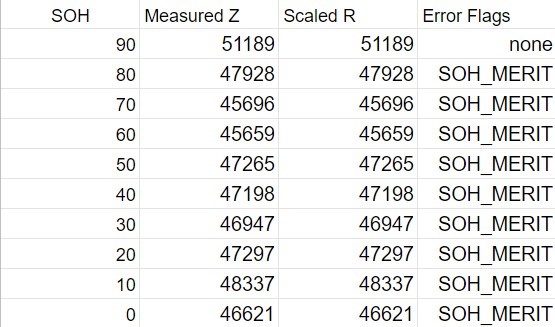Other Parts Discussed in Thread: BQSTUDIO, CC1310
Hello,
I'm using BQ35100 EVM board in EOS mode with Tadiran TL-5903 (Chem_ID: 0614) and facing the issue of unreliable SOH reading which keeps on dropping on every cycle until 0%.
I have set up everything according to Technical reference manual and other documents related to BQ35100.
Calibrated Voltage, CC gain & delta using bqstudio.
Program cell chemistry.
Write design capacity(2400mAh), design voltage(3.6V), terminate voltage(900mV), cell count(1).
Set EOS mode and togged LIFETIME_EN.
When setup with my device, I use i2c on cc1310 to communicate with BQ35100 as follow;
1. GE HIGH
2. GAUGE_START
3. ENABLE LOAD (100mA for 2s)
4. GAUGE_STOP
5. WAIT FOR GAUGE CALCULATIONS
6. Read SOH, Measured Z, Scaled R, control.
7. GE LOW
The test setup has a capacitor battery(HPC1550) connected(in parallel to load) to pack- and bat+ of BQ35100 EVM board.
LiSOCl2 battery is connected to bat+ and bat- of BQ35100 EVM board.
I have found the same issue has arise to many others as well.
As mentioned in these forums, i tried the modifications and still the SOH drops in Max Delta.
Following are the tests performed with the changes mentioned in the above forums.
Setting the Cell Terminate Voltage to 900mV.
Turn on the gauge after the battery get relaxed to overcome the SOH_MERIT, SOH_ERR, or EOS_BAD_OCV flags.
SOH Max Delta is set to 10.
I have set the New Batt R Scale Delay to 10, where i did 10 cycles as follow.
Then i set the SOH in [Gas Gauging][Design][State of health] to 100% without giving the NEW_BATTERY command. And performed the test again as below.
But, still the SOH keeps reducing in each and every cycle by Max Delta.
Thank you.
Thameera Lakshan.




